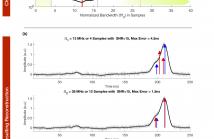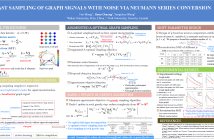
- Read more about Rethinking Super-resolution: The Bandwidth Selection Problem
- Log in to post comments
Super-resolution is the art of recovering spikes from their low-pass projections. Over the last decade specifically, several significant advancements linked with mathematical guarantees and recovery algorithms have been made. Most super-resolution algorithms rely on a two-step procedure: deconvolution followed by high-resolution frequency estimation. However, for this to work, exact bandwidth of low-pass filter must be known; an assumption that is central to the mathematical model of super-resolution.
AB_ICASSP 2019.pdf
- Categories:
 62 Views
62 Views
This work considers the problem of approximating continuous functions of finite Dirichlet energy from samples of these functions. It will be shown that there exists no sampling-based method which is able to approximate every function in this space from its samples. Specifically, we show that for any sampling based approximation method, the energy of the approximation tends to infinity as the number of samples is increased for almost every continuous function of finite energy. As an application, we study the problem of solving the Dirichlet problem on a bounded region.
- Categories:
 12 Views
12 Views
- Read more about DETECTION OF ROW-SPARSE MATRICES WITH ROW-STRUCTURE CONSTRAINTS
- Log in to post comments
An underdetermined multi-measurement vector linear regression problem is considered where the parameter matrix is row-sparse and where an additional constraint fixes the number of nonzero elements in the active rows. Even if this additional constraint offers side structure information that could be exploited to improve the estimation accuracy, it is highly nonconvex and must be dealt with with caution. A detection algorithm is proposed that capitalizes on compressed sensing results and on the generalized distributive law (message passing on factor graphs).
poster.pdf
- Categories:
 24 Views
24 Views
- Read more about FRI MODELLING OF FOURIER DESCRIPTORS
- Log in to post comments
Fourier descriptors are used to parametrically represent closed contours. In practice, a finite set of Fourier descriptors can model a large class of smooth contours. In this paper, we propose a method for estimating the Fourier descriptors of a given contour from its partial samples. We take a sampling-theoretic approach to model the x and y coordinate functions of the shape and express them as a sum of weighted complex exponentials, which belong to the class of finite-rate-of-innovation (FRI) signals. The weights represent the Fourier descriptors of the shape.
- Categories:
 20 Views
20 Views
- Categories:
 39 Views
39 Views
- Read more about ANOMALY IMAGING FOR STRUCTURAL HEALTH MONITORING EXPLOITING CLUSTERED SPARSITY
- Log in to post comments
We present a new tomography-based anomaly mapping algorithm for composite structures. The system consists of an array of piezoelectric transducers which sequentially excites the structure and collects the resulting waveform at the remaining transducers. Anomaly indices computed from the sensor waveforms are fed as input to the mapping algorithm. The output of the algorithm is a color map indicating the outline of damage on the structure when present.
- Categories:
 5 Views
5 Views
- Read more about Fast Sampling of Graph Signals with Noise via Neumann Series Conversion
- Log in to post comments
Graph sampling with independent noise towards minimum mean square error (MMSE)
leads to the known A-optimality criterion, which is computation-intensive to
evaluate and NP-hard to optimize. In this paper, we propose a new low complexity
sampling strategy based on Neumann series that circumvents large matrix
inversion and eigen-decomposition. We first prove that a DC-shifted A-optimality
criterion is equivalent to an objective computed using the inverse of a
sub-matrix of an ideal graph low-pass (LP) filter. The LP filter matrix can be
- Categories:
 40 Views
40 Views
- Read more about RECONSTRUCTION-COGNIZANT GRAPH SAMPLING USING GERSHGORIN DISC ALIGNMENT
- Log in to post comments
- Categories:
 28 Views
28 Views
- Read more about Adaptive Sensing Matrix Design for Greedy Algorithms in MMV Compressive Sensing
- Log in to post comments
Sensing matrix can be designed with low coherence with the measurement matrix to improve the sparse signal recovery performance of greedy algorithms. However, most of the sensing matrix design algorithms are computationally expensive due to large number of iterations. This paper proposes an iteration-free sensing matrix design algorithm for multiple measurement vectors (MMV) compressive sensing.
- Categories:
 28 Views
28 Views
- Read more about FRI SENSING: SAMPLING IMAGES ALONG UNKNOWN CURVES
- Log in to post comments
While sensors have been widely used in various applications, an essential current trend of research consists of collecting and fusing the information that comes from many sensors. Among these researches, combing the position information together with sensor data is particularly popular and prevalent, such as wireless sensor network localization. In this paper, on the contrary, we would like to concentrate on a unique mobile sensor. Our goal is to unveil the multidimensional information entangled within a stream of one-dimensional data. This task is called FRI Sensing.
- Categories:
 48 Views
48 Views